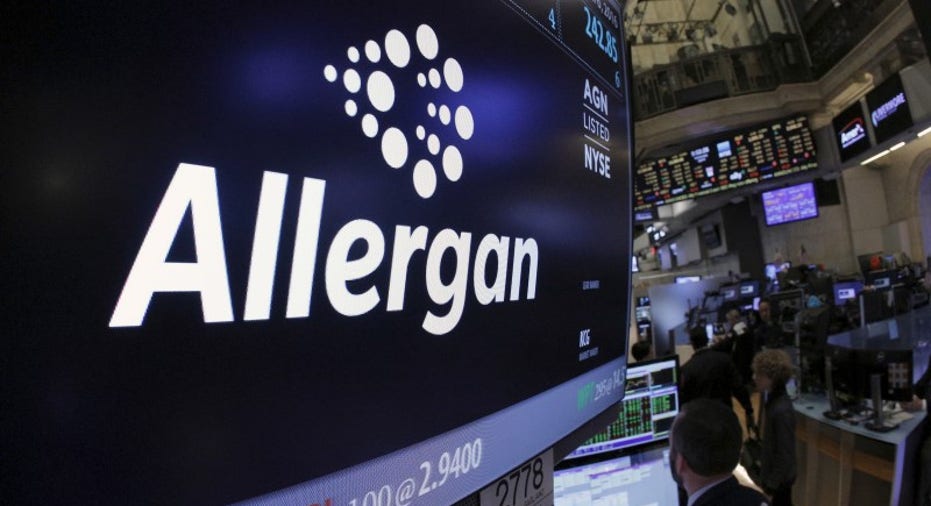Allergan pays top dollar for 'stepping stones' from neurology to dermatology

Allergan Plc CEO Brent Saunders calls them "stepping stones" - small, bolt-on acquisitions, as opposed to the mega-deals common in the drug industry. And they're expected to boost dealmaking in sectors ranging from neurology to skin care.
Allergan's agreement on Tuesday to acquire liver drug developer Tobira Therapeutics Inc for $1.7 billion may seem trivial compared to the proposed $160 billion deal Allergan crafted last year to sell itself to Pfizer Inc .
But that deal was torpedoed in April by the U.S. Treasury's latest curbs on tax inversions. Now the company, domiciled in Ireland, is taking a new tack, preparing to spend a war chest of more than $20 billion on stepping-stone deals.
The small deals are aimed at filling gaps in its core therapeutic areas, which range from the central nervous system and gastrointestinal diseases, to dermatology and eye care.
Allergan has added four other small companies to its portfolio this year, three of which sold for less than $100 million upfront, plus performance payments. Two, ForSight Vision and Retrosense Therapeutics, treat eye disorders. The others, Topokine Therapeutics and Vitae Pharmaceuticals Inc. , focus on dermatology.
Allergan agreed to acquire Vitae last week for $639 million.
The fact that Allergan is paying top dollar for some of these companies - including a nearly 600 percent premium for Tobira, excluding performance payments - has investors and dealmakers speculating about the company's next stepping stone.
Logical acquisition targets for Allergan would include Acadia Pharmaceuticals Inc , a maker of treatments for Parkinson���s disease; Intra-Cellular Therapies Inc , a developer of psychiatric medications; Neurocrine Biosciences Inc , which focuses on neurology and women���s health; and Dermira Inc , a dermatology company, according to investment bankers and industry investors.
In an interview with Reuters, Saunders declined to comment on any specific companies that Allergan may want to acquire next. But he said that stepping stones will play a key role in helping the company continue to meet its ambitious annual revenue growth target of 10 percent for years to come.
"I needed to do big deals to get where we are, but the strategic vision was always to get to a point where we could use stepping stones," Saunders said.
Allergan has relied heavily on M&A because it views inventing its own drugs in-house as too risky. Saunders, 46, has attempted or executed mergers and acquisitions totaling more than $300 billion in the last three years.
Allergan now has the money to embark on a major acquisition spree thanks to the sale of its generic drug portfolio to Teva Pharmaceutical Industries Ltd . Allergan received $33.4 billion in cash and $5.1 billion in Teva stock last month as a result of that deal.
While Allergan has pledged to spend some of those dollars on share buybacks, it will still have cash reserves of more than $20 billion it can spend on deals.
Allergan wants to build out its central nervous system franchise, which is one of the largest in the industry and treats diseases including Alzheimer's, depression, migraines and schizophrenia, Saunders said.
He added that he would like to branch out into other types of neurological treatments, including multiple sclerosis, attention deficit hyperactivity disorder and Parkinson's disease.
One of Allergan's successful endeavors in the central nervous system space, its Namenda Alzheimer's franchise, took a hit over the past year after one of its key drugs, Namenda IR, lost patent protection. Namenda IR generated more than $500 million in 2015.
Allergan is hoping that a ramp-up of its newly commercialized anti-psychotic drug, Vraylar, can help offset that decline.
BOTOX AS A GATEWAY DRUG
Saunders said he also is optimistic about opportunities in dermatology and eye care, adding that he would be open to a medium-sized deal to build out its opthalmic products.
In dermatology, Allergan has the world's biggest franchise by sales, largely due to its flagship drug, Botox, for wrinkle-smoothing.
Last year, in a stepping-stone acquisition, Allergan bought a publicly traded dermatology company called Kythera for $2.1 billion, and it has been ramping up sales of its key drug, Kybella, which treats double chins.
"There's definitely potential for more deals like that in dermatology," said Randall Stanicky, an analyst at RBC Capital Markets. "Botox is a gateway product into the entire world of aesthetics."
In the interview, Saunders left open the possibility of a transformative acquisition or merger for Allergan, which has a market capitalization of $95 billion.
He said a company with a cutting-edge treatment that reversed Alzheimer's was an example of the type of big deal Allergan would consider making.
Biogen Inc and Eli Lilly and Co both have late stage drugs that promise to reverse the effects of the degenerative neurological disease. Biogen and Eli Lilly have market capitalizations of $65 billion and $86 billion, respectively.
Reuters reported in August that Allergan had held informal conversations with some members of Biogen's board before deciding against any acquisition offer.
(Reporting by Carl O'Donnell in New York; Editing by Greg Roumeliotis and Brian Thevenot)